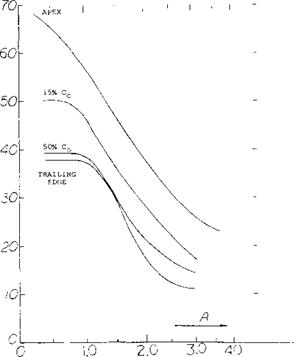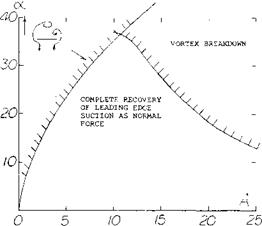VORTEX BREAKDOWN – WING STALL
The Leading-edge vortex formed by a delta wing proceeds downstream as a tightly rolled tube illustrated in figure 3, until it becomes unstable and experiences an abrupt expansion, vortex bursting. At the lower angles of attack the abrupt expansions occur downstream from the trailing edge. As the angle of attack and/or aspect ratio of the wing is increased the vortex bursting moves upstream and intersects the wing trailing edge. With further increases of A and/or o’ the breakdown moves forward, ending at the vortex of the wing. Although there are two types of vortex breakdown (12,a) no attempt is made here to find differences on the wing lift.
Effect on Lift. When the vortex breakdown occurs aft of the wing trailing edge, the vortex lift predicted by equations 1 and 3 continues to increase with angle of attack. This occurs because the vortex reattaches as required by the leading-edge suction analogy. As the vortex bursting position approaches the wing trailing edge reattachment fads and the lift is reduced. This lift reduction occurs when the vortex is slightly aft of the trailing edge of delta type wings as the vortex producing the lift is helical in nature, requiring area for full recovery of lift (12,f). The reduction of lift occurs as shown on figure 25 as the vortex breakdown moves forward on the wing preventing reattachment until the bursting at the vortex of the wing. At this point the vortex lift is zero At this point it should be noted that tests (12 ,g) show blowing near the wing leading edge tends to prevent vortex breakdown. This allows the lift to follow that predicted by the suction analogy (5,a).
|
Figure 25. Leading edge vortex breakdown position for sharp edge delta wings. |
|
|
|
VORTEX CONTACT OR ASSYMETRY |
|
CHAPTER IV 2D BUBBLE BURSTING/ |
|
///// |
|
Figure 26. Limits of angle of attack for vortex breakdown or intersection. |
Vortex Breakdown Position. The angle of attack and
wing aspect ratio influence the location of the vortex breakdown position as shown on figure 26. The position for the vortex bursting has been obtained from flow visualization techniques, such as smoke (12,a) and is a good indication where the reduction in vortex lift will occur, and the extent.
Slender Wings. In the case of very slender wings, low aspect ratio, the vortices on either side will make contact or have an asymmetry before vortex breakdown occurs. In this case the height of the vortices above the wing are different producing a difference in lift that causes a strong rolling moment. This results in another limitation in lift. The conditions for the contact have been determined from rolling moment data (12 ,d) and are given on figure 26.
(13) Flaps on delta wings:
a) Corsiglia, Large-scale Test Low A Delta Wing, TN D-3621.
b) Holford, Split Flaps on 48° Delta Wings, A = 3.03, ARC R&M 2996.
c) Hawes, Constant-chord Ailavator on a Triangular Wing, NACA RM L51A26.
d) Brown, A = 1.85 Delta Wing with Double Slotted Flaps, NACA RM L56D03.
e) Croom, Thin 60° Delta Wing with Double Slotted Flap, NACA RM L54L03a.
f) Spencer, Longitudinal Control Delta Wings with Nose Deflection and Trailing-edge Flaps, NASA TN D-1482.
g) Thomas, Wing-tip Controls on Delta Wings, ARC R&M No. 3086.
h) Koenig, Delta-wing with Mid Chord Flaps, NACA TN D-2552.
















